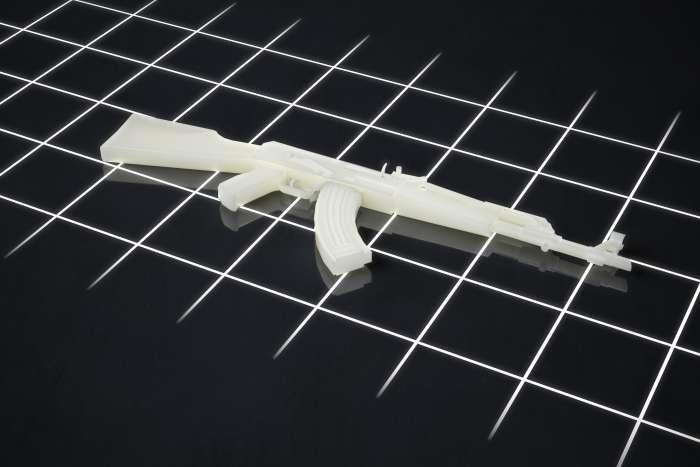- FMA
- The Fabricator
- FABTECH
- Canadian Metalworking
Our Publications
Categories
- Additive Manufacturing
- Aluminum Welding
- Arc Welding
- Assembly and Joining
- Automation and Robotics
- Bending and Forming
- Consumables
- Cutting and Weld Prep
- Electric Vehicles
- En Español
- Finishing
- Hydroforming
- Laser Cutting
- Laser Welding
- Machining
- Manufacturing Software
- Materials Handling
- Metals/Materials
- Oxyfuel Cutting
- Plasma Cutting
- Power Tools
- Punching and Other Holemaking
- Roll Forming
- Safety
- Sawing
- Shearing
- Shop Management
- Testing and Measuring
- Tube and Pipe Fabrication
- Tube and Pipe Production
- Waterjet Cutting
Industry Directory
Webcasts
Podcasts
FAB 40
Advertise
Subscribe
Account Login
Search
Man sentenced to eight years for possessing AR-15 made with 3D-printed components
- February 16, 2019
- News Release
- Additive Manufacturing
The following is an edited excerpt of a statement released by the Department of Justice, the U.S. Attorney’s Office for the Northern District of Texas.
A Dallas man was sentenced to eight years in prison Feb. 13 after officers caught him with a partially 3D-printed AR-15 rifle and a list of lawmakers’ addresses in his backpack, despite a court order that prohibited him from possessing a firearm, announced U.S. Attorney for the Northern District of Texas Erin Nealy Cox.
In August 2015, a county judge enacted a protective order against Eric Gerard McGinnis, then 39, following a violent altercation with a live-in girlfriend. Despite that order–which barred him from possessing firearms or ammunition for two years–McGinnis attempted to buy a semiautomatic rifle component at a federally licensed gun shop in June 2016. The prospective purchase was rejected after a background check uncovered the order, and the Bureau of Alcohol, Tobacco, Firearms and Explosives (ATF) reminded McGinnis he wasn’t allowed to have a gun.
McGinnis then obtained a barrel, stock, upper receiver, and grip, and used a 3D printer to create a “lower receiver,” the gun’s firing mechanism, and assembled the parts to construct a short-barrel, AR-15-style rifle.
In July 2017, with just slightly more than one month left on his protective order, McGinnis took the 3D-printed gun to a wooded area outside Dallas. Local police officers, out on another call, heard three shots fired and eventually located him near a major road. Ordered to put his hands up, McGinnis falsely claimed he was a member of the CIA.
Body-cam video shows that officers directed him to kneel on the pavement, cuffed him, and shortly thereafter inspected his backpack. In it, the officers discovered the partially 3D-printed, loaded gun and a list labeled “9/11/2001 list of American Terrorists.” The hit list included office and home addresses of several federal lawmakers, both Democrat and Republican.
A subsequent forensic analysis of McGinnis’ electronic devices suggested he had a strong interest in James Hodgkinson, the shooter who wounded Rep. Steve Scalise and several others at a GOP Congressional baseball practice in Virginia in June 2017.In a jailhouse phone call to a family member, McGinnis admitted he’d “printed” part of the gun.
“I didn’t buy a gun, I built the gun,” he said in the recorded phone call. “The upper, I printed a lower, and I built it—installed the trigger and did all that stuff. I built it.”After a two-day trial presided over by Chief U.S. District Judge Barbara M.G. Lynn, a jury found McGinnis guilty of possessing an unregistered short-barrel rifle and unlawfully possessing ammunition while subject to an active protective order.
This case, investigated by the ATF with assistance from the Grand Prairie (Texas) Police Department and U.S. Capitol Police, was brought as part of U.S. Attorney Nealy Cox’s initiative to keep firearms out of the hands of domestic abusers. Assistant U.S. Attorneys Brian McKay and Rick Calvert prosecuted the case.
“When he realized he couldn’t legally purchase a firearm, Eric McGinnis circumvented our gun laws by 3D-printing his weapon, eliminating the need for a background check,” said Nealy Cox. “This case should send a message to prohibited persons contemplating acquiring guns by any method (that) this office is committed to keeping guns out of the hands of those who violate protective orders for domestic violence, no matter how the guns are obtained–by theft, purchase, or 3D printing.”
Click here to read the full statement.
- Podcasting
- Podcast:
- The Fabricator Podcast
- Published:
- 04/16/2024
- Running Time:
- 63:29
In this episode of The Fabricator Podcast, Caleb Chamberlain, co-founder and CEO of OSH Cut, discusses his company’s...
- Trending Articles
- Industry Events
16th Annual Safety Conference
- April 30 - May 1, 2024
- Elgin,
Pipe and Tube Conference
- May 21 - 22, 2024
- Omaha, NE
World-Class Roll Forming Workshop
- June 5 - 6, 2024
- Louisville, KY
Advanced Laser Application Workshop
- June 25 - 27, 2024
- Novi, MI

























